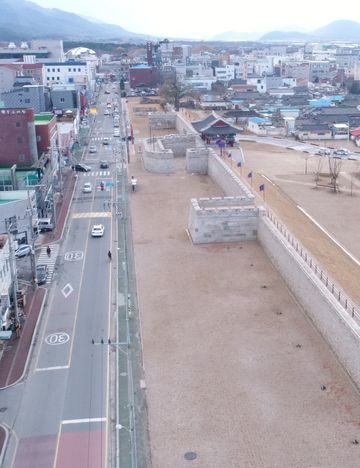경주읍성
| 경주읍성 Gyeongjueupseong Walled Town |
|
 경주읍성, 국가문화유산포털, 문화재청. |
|
| 대표명칭 | 경주읍성 |
|---|---|
| 영문명칭 | Gyeongjueupseong Walled Town |
| 한자 | 慶州邑城 |
| 주소 | 경북 경주시 북부동 1번지 |
| 지정(등록) 종목 | 사적 제96호 |
| 지정(등록)일 | 1963년 1월 21일 |
| 분류 | 유적건조물/정치국방/성/성지 |
| 시대 | 고려시대 |
| 수량/면적 | 45,496㎡ |
| 웹사이트 | 경주읍성, 국가문화유산포털, 문화재청. |
|
|
|
해설문
국문
읍성은 고을의 주민을 보호하고, 군사 행정 기능을 함께하는 성을 말한다.
경주읍성은 『동경통지(東京通志)』에 고려 현종 3년(1012)에 쌓았던 것을 우왕 4년(1378)에 고쳐 쌓았다고 한다. 조선시대 세종, 선조, 인조, 영조에 이르기까지 증․개축과 내․외부의 구조 변경이 있었음을 문헌기록을 통해 확인할 수 있다. 2016년 복원정비를 위한 발굴조사 과정에서 흙으로 처음 쌓은 성벽의 기초와 우왕 때 돌로 고쳐 쌓은 성벽의 기초가 확인되어 문헌에 기록된 사실이 증명되었다.
읍성 안에는 조선 태조의 어진(御眞)*을 봉안한 집경전(集慶殿)과 관아(官衙) 외에도 사방으로 향일문(向日門), 망미문(望美門), 징례문(徵禮門), 공신문(拱辰門)이 설치되었으며, 성벽 바깥으로 해자(垓子)*도 갖추고 있었다. 『문종실록(文宗實錄)』에 둘레 4,075척(약 1,904m), 높이 11척 6촌(약 5.4m) 등 비교적 정확한 구조와 규모가 설명되어 있다.
남문인 징례문 밖 봉황대 옆에 성덕대왕신종을 걸어 매일 시각을 알려 주었다고 한다. 또 임진왜란 때에는 이장손(李長孫)이 발명한 비격진천뢰(飛擊震天雷)를 처음으로 사용하여 왜군을 물리쳤던 곳이기도 하다.
일제강점기에 대부분 헐리고 동쪽성벽 90m 정도만 남아 있었는데, 2018년 동쪽 성벽과 향일문[동문] 일대를 복원, 정비하였다.
- 어진(御眞) : 왕의 얼굴을 그린 그림. 초상화. 진용(眞容)·어영(御影) 등
- 해자(垓子) : 적의 침입을 막기 위해 성 밖을 둘러 파서 못으로 만든 곳.
영문
Gyeongjueupseong Walled Town
A walled town, called eupseong in Korean, was established at an important location in an area to protect residents and serve military and administrative functions. It consisted of a fortress wall with bastions and gates, the magistrate’s office and residence, a guesthouse where visiting officials stayed and where rituals honoring the king were held, and other offices for the various lower-level clerks who managed the administration of the local area.
The walled town of Gyeongju was first established in 1012 and later rebuilt in 1378 during the Goryeo period (918-1392). During the Joseon period (1392-1910), it was renovated, expanded, and repaired various times. During the Japanese invasions of 1592-1598, this was the first place that a cannon bomb technology invented by Yi Jang-son was used. During the Japanese colonial period (1910-1945), much of the walled town was demolished by the Japanese authorities, and only 90 m of the eastern wall remained. In 2018, the eastern wall and eastern gate, called Hyangilmun, were rebuilt based on archaeological evidence and historical records.